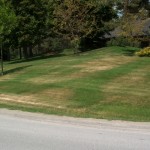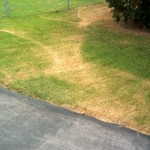(Written July 2010) It has been a brutally dry year overall for grass. Two years of record wet summers followed by a record dry Spring in decades has been followed by unseasonably high temperatures and humidity. The few long rains we’ve had were welcome, but they didn’t make a big dent in our water debt, and the fast rain from thunderstorms just runs off. People are having a lot of trouble watering their lawns enough to keep them healthy. So lawns are getting sick right now, both from dehydration and a summer fungus called blight or summer patch. You can fix both problems yourself.
Think about how rough you feel after working in this heat. After cutting your grass you are dying for a drink of water, and the humidity makes you feel sick. Your grass is out in that same heat and it can’t come inside to cool off. The drought is bad enough, but the thick humidity and well-meaning attempts to fight the drought are also causing blight. Blight thrives between 24°C and 32°C, sending out spores to infect more grass when the temperature is above 21°C. Infected grass first turns light green, then reddish-brown, then tan, and finally straw-coloured. Many homeowners mistake blight for drought and frantically water the lawn in the heat of the day. But that just makes blight worse.
The key to telling blight from drought is location and context. Blight is most noticeable where it is normally moist and where there has been recent mechanical activity on a lawn which exacerbates the condition. You are more likely to find it in partly shaded and low-lying areas and the north side of lawns. Drought damage appears most on south-facing hills with little or no shade, and prone to dessication.
Both problems can be fixed by the same good cultural practices. First, make sure your lawnmower blade is good and sharp. The tearing caused by a dull mower blade make it easy for blight and other disease to infect grass, and makes grass lose more water from evaporation. Second, mow and water early in the morning. The lawn will be able to heal the cut tips before the sun gets too high in the sky, and any water the grass can’t absorb will evaporate gently, preventing both the dampness that fungus loves and the scalding that hits a wet lawn under full sun. Lawns need about two inches of water a week when it is this hot. Water deeply to train roots to grow deeper- consistently! It also helps to rake out any dead grass or clippings from mowing which may harbour blight spores, and let your grass grow a bit taller to three inches to shade the ground better.
Your lawn care professional can help too. An application of the proper nutrients and kelp can help your grass grow through the injury. LawnSavers also offers our kelp bio-stimulant. This all-natural product is loaded with micronutrients and natural phytochemicals that can really help grass recover from stress injury and disease. Contact us for a quote!








